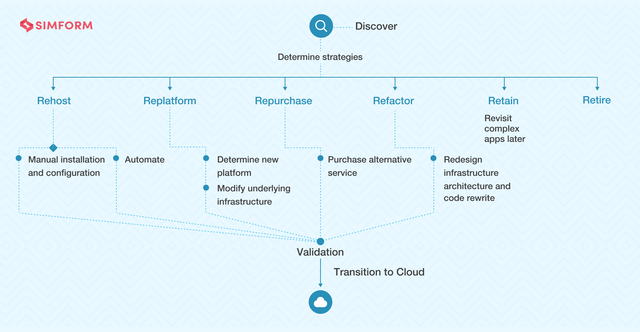Cloud Migration Strategy – The Ultimate Guide to the 6 R’s

Move your business elements, data, and applications to a cloud environment by choosing the most suitable cloud migration strategy. This blog introduces you to those six cloud migration strategies, including their use cases, popular examples, and best practices. So get started to reading a useful post before your organization plans a migration process.
Embracing the power of the cloud has become inevitable to succeed in today’s digital era, especially when organizations are increasingly migrating their applications to the cloud to drive growth. According to Gartner, the worldwide spending on public-cloud services is forecast to grow up to $304.9 billion in 2021, up from $257.5 billion in 2020. By 2024, more than 45% of the IT spending will shift from traditional solutions to the cloud.
Despite such heavy spending on the cloud, one in every three organizations fail to realize its benefits. 33% of organizations have seen no or slight improvement in organizational effectiveness after cloud adoption, as per Unisys Cloud Success barometer report. Cloud migration is a complex and costly affair. So how do you avoid a cloud project failure?
The answer lies in proper planning and selecting the right cloud migration approach for your IT assets. This blog aims to give you a better understanding of a suitable cloud migration strategy to help you create a path for migration and smoothly transition to the cloud.
What is Cloud Migration?
Cloud migration isn’t just about moving to the cloud; it is an iterative process of optimization to reduce costs and reach the full potential of the cloud. It impacts all the organizational aspects including people, processes, and technology. But with flexible consumption and pricing models, the cloud can support high scalability, performance, agility, remote work, and cost-efficiency.
The 6 R’s of Cloud Migration Strategy
1. Rehost
Say you want to move your on-premises Oracle database to an EC2 instance in AWS with little upfront effort. Then rehosting is for you! It’s one of the quickest and easiest cloud migration strategies that moves data without code-level changes.
2. Replatform
This ‘lift, tinker and shift’ strategy is a modified version of rehosting. Replatform enables you to make a few configurational changes to the apps to better suit the cloud environment without changing their core architecture. Developers commonly apply this approach to change the way apps interact with the database so they can run on managed platforms like Google CloudSQL or Amazon RDS.
3. Refactor/Re-architect
Refactor or Re-architect method involves rewriting your applications from scratch to make them cloud-native. This strategy allows you to realize the full potential of cloud-native technologies like microservices architecture, serverless, containers, function-as-a-service, and load balancers. For example, you can refactor assets when you move your digital assets from an on-premise monolithic architecture to a fully serverless architecture in the cloud. These refactored applications are scalable, agile, efficient, and return ROI in the long run, even in the most competitive markets.
4. Repurchase
Repurchase, also known as the “drop and shop” strategy, replaces the on-premise application with a cloud-native vendor-packaged software. It typically means moving to a SaaS (Software as a Service) application with the same capabilities. Effectively, it entails a licensing change sometimes––you drop the existing on-premise license and start a new license agreement with the cloud provider for their solution. The newer, upgraded cloud version offers you a better value with higher efficiency, savings on app storage, and maintenance costs.
5. Retire
In the ‘retire’ strategy, you get rid of applications no longer needed or productive for your IT portfolio. If an application is considered not worth migrating to the cloud, it can either be eliminated or downsized. It allows you to explore all your applications in terms of their uses, dependencies, and cost to the company. It is a rather passive strategy as there is no migration. According to Stephen Orban at AWS, as much as 10% of an enterprise IT portfolio is no longer useful when migrating to the cloud and can be simply turned off.
6. Retain
Retaining, also referred to as re-visit, is revisiting some critical applications/portions of your digital assets that need a significant amount of refactoring before migrating them to the cloud. Eventually, you may figure out some applications are more suitable to on-premise arrangements or have been recently upgraded and need to be retained. In other cases, applications are retained due to latency requirements, compliance or regulatory constraints, or it’s simply not cost-efficient.
Best Practices for a Successful Cloud Migration
- Know your IT portfolio inside out –the data, applications, and infrastructure
- Design your migration strategy
- Select the right partner for your cloud migration journey
- Prepare your team and the existing IT environment for the transition
- Leverage automated tools and managed services from cloud services provider wherever possible
- Track and monitor the migration process continuously
- Test and validate for optimization
Check out the original article to read more about Cloud Migration Strategy.